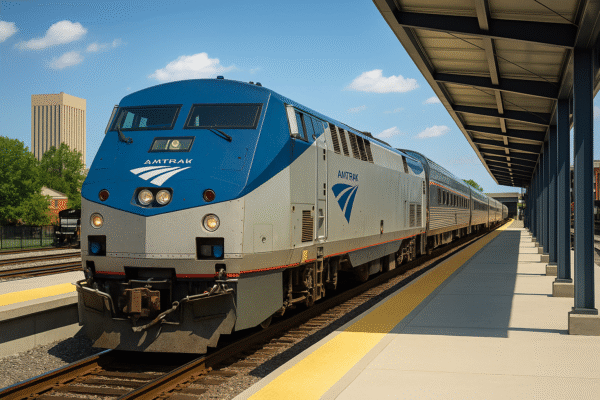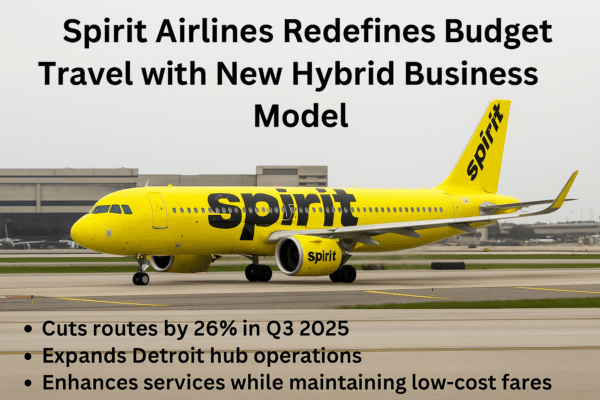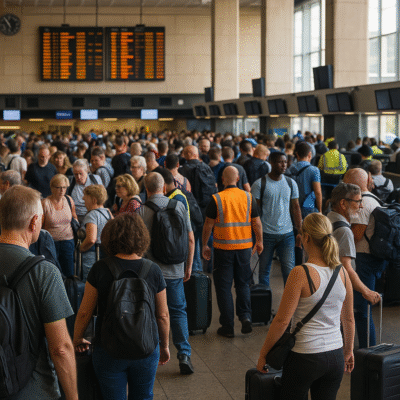[United States – August 2025] – In a bold move that reshapes its position in the U.S. aviation landscape, Spirit Airlines is undergoing a transformative restructuring to improve operational efficiency, grow core markets, and enhance the passenger experience. The airline is shifting from its ultra-low-cost carrier (ULCC) roots to a hybrid model that offers both affordable fares and upgraded services, signaling a new era for the budget airline sector.
Major Network Adjustments and Q3 2025 Flight Cuts
In its latest quarterly review, Spirit Airlines announced a 26% cut in daily flight movements—a strategic step to refine its operations and ensure sustainable profitability. From July to September 2025, the airline will operate an average of 616 daily flights, down from 831 during the same period in 2024.
Among the most significant changes, Chicago O’Hare International Airport, once a central hub, has been dropped from the top 10 busiest airports in Spirit’s network due to a 40% reduction in flights. Baltimore-Washington International Airport moved up in rank despite a 25% reduction, while Los Angeles International Airport (LAX) saw a dramatic 45% cut in daily services.
Conversely, Florida-based strongholds like Fort Lauderdale-Hollywood International Airport and Orlando International Airport retained a relatively stable number of flights, reaffirming Spirit’s commitment to its Florida roots.
Detroit Emerges as a Strategic Growth Hub
While most airports have seen reductions, Detroit Metropolitan Wayne County Airport (DTW) is witnessing a remarkable 27% year-over-year growth in Spirit’s flight operations. The number of destinations served from Detroit surged from 22 in Q3 2024 to 41 in Q3 2025, making it Spirit’s fourth busiest airport.
This expansion includes new direct routes to Austin, Charlotte, Baltimore, Phoenix, Raleigh/Durham, and San Diego—key strategic moves to tap into growing demand from the Midwest and position Detroit as a powerful hub in the airline’s network.
The airline’s exit from Chicago O’Hare makes room for Detroit to become a key alternative for Midwest travelers seeking affordable, well-connected domestic and international options.
Hybrid Business Model: Balancing Cost and Comfort
Spirit is shedding the image of a “no-frills” airline by adopting a hybrid service model—a concept gaining traction among value-focused carriers. The transformation includes:
- Upgraded aircraft cabins with improved seating and legroom
- Introduction of bundled service packages for baggage, seat selection, and refreshments
- Potential implementation of loyalty perks and travel flexibility options
While these enhancements are expected to increase operational costs, Spirit forecasts a rise in revenue per passenger and customer satisfaction—key metrics for sustained profitability in today’s competitive aviation market.
Expansion Despite Route Cuts: New Destinations in 2025
Although Spirit has exited certain underperforming routes—such as those to Cap-Haïtien (Haiti), Guayaquil (Ecuador), and Port-au-Prince—the airline has added six new destinations for Q3 2025:
- Birmingham, AL
- Bucaramanga, Colombia
- Chattanooga, TN
- Columbia, SC
- Lima, Peru
- Savannah, GA
This expansion takes Spirit’s total served destinations to 85 airports, up from 82 in the same quarter last year.
The upcoming addition of Key West, FL, and Macon, GA—the latter potentially supported through a regional alliance with Contour Airlines—demonstrates the carrier’s focus on tapping into underserved regional markets. This collaborative model may serve as a blueprint for future partnerships.
Industry Challenges: Navigating Engine Shortages and Fleet Restructuring
Spirit’s transformation comes amid wider industry challenges, including aircraft engine shortages, delayed deliveries, and rising operational costs. The airline has been actively restructuring its fleet strategy to minimize disruptions while modernizing aircraft to align with the hybrid model.
Despite these hurdles, Spirit’s leadership remains confident that their streamlined network, tech upgrades, and enhanced in-flight experiences will win over a broader customer base while keeping operational costs lean.
Customer Benefits: What Travelers Can Expect
For travelers, the new Spirit experience aims to deliver:
- Greater network connectivity in emerging secondary markets
- More reliable scheduling from optimized flight planning
- Competitive fares with bundled value options
- Improved onboard comfort and upgraded airport amenities
These changes are expected to not only retain existing loyalists of budget travel but also attract new customers previously reluctant to fly Spirit due to its no-frills reputation.
Conclusion: A New Chapter in U.S. Budget Aviation
With a clear focus on profitability, flexibility, and market expansion, Spirit Airlines is navigating its most ambitious transformation yet. From Detroit’s rise as a core hub to its smart shift toward hybrid services, the airline is poised for long-term growth and competitiveness in an evolving travel ecosystem.
As Spirit continues to streamline its operations and refine its identity, travelers can expect a more consistent and comfortable flying experience—without straying too far from the brand’s original commitment to affordability.
For more updates on travel, aviation, and destination insights, stay tuned to Global Travel Wire.




















